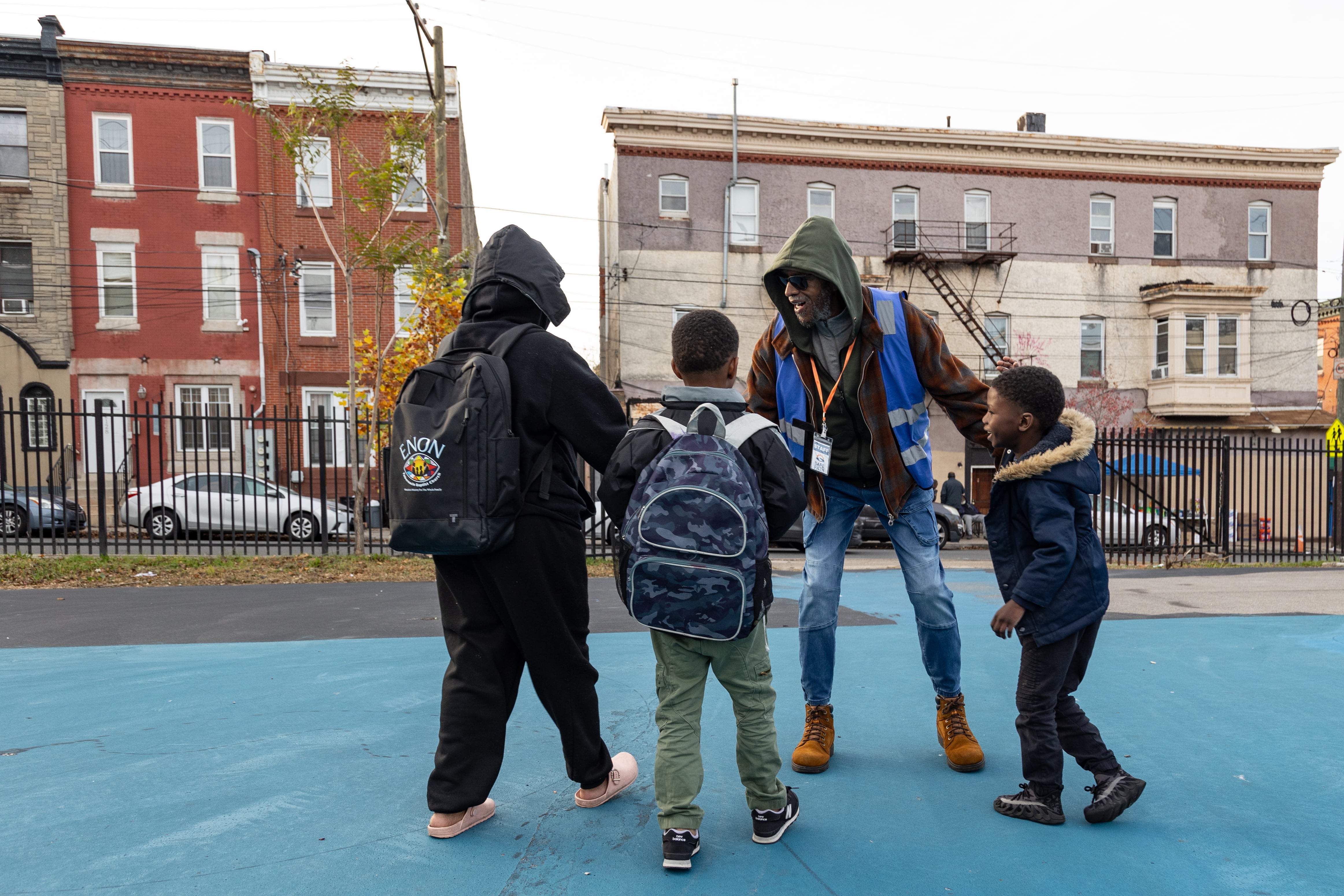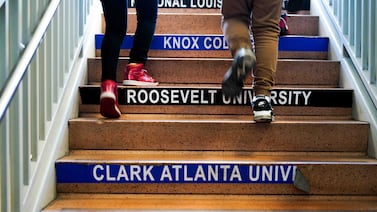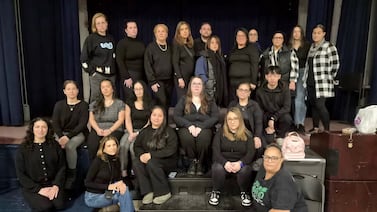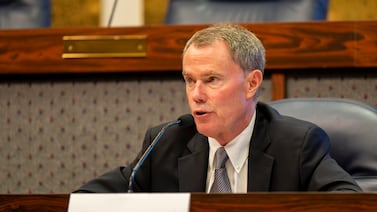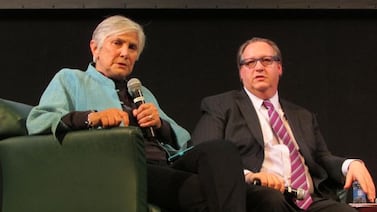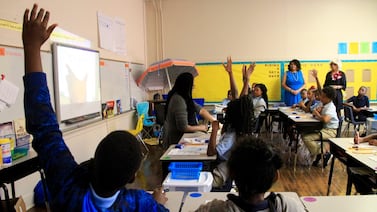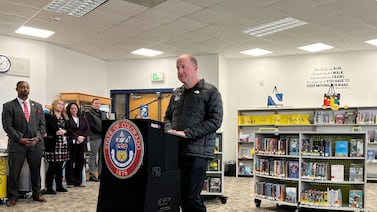Sign up for Chalkbeat Philadelphia’s free newsletter to keep up with news on the city’s public school system.
The noise outside Marc Rentas’s Kensington home was typical for 2:30 p.m.
It always gets loud during dismissal time at nearby Jules E. Mastbaum High School, Rentas said. But one afternoon this fall, the energy was different.
“There was a group of kids on the sidewalk, they were throwing trash,” he said. “A huge fight broke out. … People were scared.”
He said one student threw a flower pot at another student, and a different student bumped Rentas’s elderly father. That’s when he called the school district. Meanwhile, nearby neighbors called the police. It took 30 minutes for officers to break up the fight, Rentas said.
Prior to the start of this school year, Mastbaum High was one of 24 campuses that had the Safe Path program. Safe Path aims to both quell schoolyard fights and protect children from shootings by hiring attentive adults from the community, known as “monitors.” These adults — recognizable by their blue vests — patrol campus perimeters and stand watch on school property, regularly greeting students and sometimes walking them home or to a transit stop.
But this fall, the school district ended a partnership with the largest provider of Safe Path services. The district hired new contractors, but those organizations haven’t gotten underway at the majority of schools that used to have the program. And a few other schools didn’t see Safe Path return — or saw it return late — due to dwindling funds and holdups with training and recruitment.
That means for the last three months, the cadre of watchful neighborhood monitors has been missing from some of the schoolyards and street corners that need the most protection.
The week of the big fight at Mastbaum, Principal David Lon said the Safe Path monitors haven’t come back so far this year. He said he appreciated the service when it was in place.
Since piloting the program in 2022 and expanding it in 2023, the district has touted Safe Path as crucial to its wider gun violence prevention plan. Data from the program’s first year suggests it successfully reduced incidents of violence in the schools where it operated. And studies indicate similar programs in other U.S. cities have improved student safety.
“It’s unfortunate there was this gap in safety for our youth because the city took so long to make decisions,” said Jackie Bonner of the Institute for the Development of African American Youth, Inc., or IDAAY, a former contractor for Safe Path.
IDAAY got an email from the district at the end of September — roughly a month after the first day of school — notifying the group its contract wouldn’t be renewed.
Two other nonprofit organizations, Eddie’s House and Educators 4 Education, will provide Safe Path services for the district. But the school district has not said when Safe Path will return to the 17 schools where IDAAY used to provide monitors.
“There’s still a lot of stuff being worked out,” said Marion Campbell, executive director of Eddie’s House, in late November. “I know everyone is trying to get it done as soon as possible.”
Educators 4 Education recently put up a job posting for Safe Path monitors. President Anthony Singleton said his organization has already received 400 applications, including from monitors formerly employed by IDAAY, and are working to onboard those people.
“Of course we would have liked to start at the beginning of the school year, but it’s not always a perfect fit,” Singleton said. “We are hoping to get everyone up and running.”
Safe Path works with schools on student safety
Not all Safe Path schools were missing their monitors this fall. At Dr. Tanner G. Duckrey Public School in North Philly, the adults in blue vests are hired by Eddie’s House, which has provided the service there since 2023.
At the end of each school day, Safe Path monitor Saleem Gilliard takes his place near the schoolyard. He stands between the back doors of the K-8 school and the corner of 16th Street and Susquehanna Avenue and waits for the students to pour out.
“I’m looking for crowds or groups of kids,” he said. “When it’s rowdy, we break it up and send them home.”
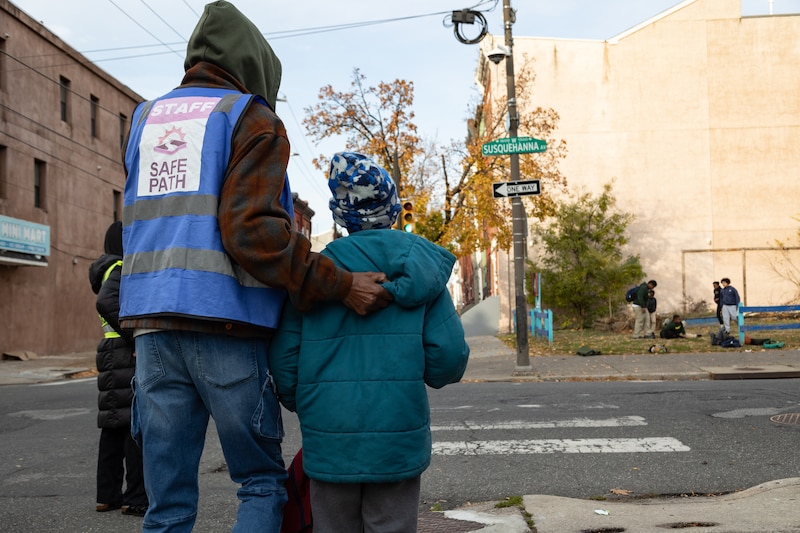
Gilliard is 74. He applied because he wanted a part-time job that would allow him to steer children toward brighter futures, he said. The program employs and trains adults, with an emphasis on hiring from the nearby community.
Like many young people in major cities, Philadelphia students risk getting involved in fights on campus and on nearby streets, and being shot on their commutes to school.
The likelihood of a child being injured by firearms increases 45% between 2 p.m. and 6 p.m., according to a new Boston University study comparing shooting data in New York City to public school calendars. The study notes that most of these shootings are committed by adults in the surrounding community, and that Safe Path programs are a key solution.
Dismissal time is also a prime window for large fights — such as one in early November at Frankford High School that went viral on social media and prompted a school assembly. Frankford has never had the Safe Path program.
And back-to-school season is an especially chaotic time because some kids haven’t seen each other all summer, according to Reuben Jones with the violence prevention group Frontline Dads, also a former Safe Path contractor.
“If there’s no presence there, it sets the tone for the rest of the year,” he said. It leads students to believe that “‘Nobody’s around to hold me accountable.’ It becomes a free for all. It’s dangerous actually.”
Until this fall, Frontline Dads provided Safe Path services through the Penn Injury Science Center at the University of Pennsylvania. In a partnership with the district that began in 2023, the center began overseeing Safe Path in nine schools, including two of the 17 schools where IDAAY was operating.
But Bernadette Hohl, a senior research investigator at the Penn center, said they ended their partnership with both IDAAY and Frontline Dads due to funding changes and only brought the program back to seven schools.
Not all of the Penn-contracted monitors started on the first day of school due to recruitment and training, but they are all staffed now, according to Hohl.
The lapse in Safe Path coverage could undermine a program that was working, school district data indicates. In the year before Safe Path launched, the district recorded 166 “serious incidents” at the selected schools between 2 p.m. and 5 p.m., according to school board documents.
In the first year of Safe Path implementation there were 125, reflecting a 26% decrease.
The decline occurred while Philadelphia on the whole experienced a significant drop in fatal and nonfatal shootings.
Philly’s program replicates a more-established model in Chicago, which reduced violent crime around selected schools by 14%, according to a study of 15 years of data across 140 schools. That study did not look specifically at fights as a metric. The Safe Passage program in Pittsburgh that began in 2021 achieved similar results.
Safe Path monitors can pick up on patterns of bullying, or hear about conflicts between students, and report those to school administrators so they can take preventive action, Bonner said.
And in rare cases, they can respond to serious threats.
When an adult showed up with a gun during a dismissal hour fight near Overbrook High School this May, Safe Path monitors kept students away while officers confronted the gunman, Bonner said.
And last June, when a group of students from one high school said they were taking guns over to a middle school, Safe Path monitors overheard and told Bonner. She contacted the police and warned the middle school principal.
“We’re the eyes and ears outside,” Bonner said. “So to not have that layer in place, it can have some very negative consequences.”
A contract change for Safe Path worries observers
The school district confirmed it is no longer partnering with IDAAY, and said the delay in restarting the program was due to changes in its “procurement process.” The district paid IDAAY about $2.1 million for Safe Path services last year, the group said.
The district declined to provide more details about the months-long lag at many schools, but said the program “is currently ramping back up to full capacity.”
Bonner said she’s more frustrated about the district’s lack of communication at the start of the school year than she is about its choice to use another vendor: “I don’t like how quiet it is.”
Jones, of Frontline Dads, echoed Bonner’s concerns.
“It speaks to the lack of 100% commitment to preserving the safety of those students,” he said. “If that were the goal, you’d make sure those things were in place before school started.”
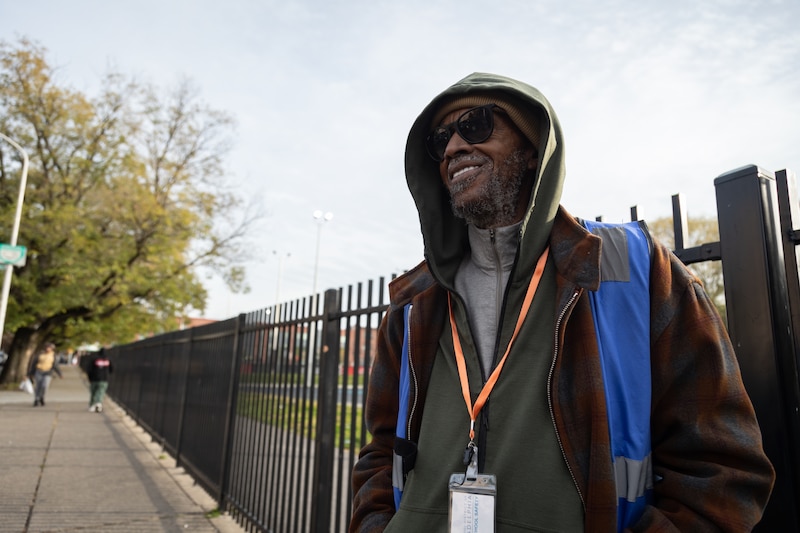
And by next summer, there could be more changes to Safe Path because a grant the Penn Injury Science Center used to support the program is ending.
Hohl, of the center, said staff there will continue to look for funding.
“Students want to feel like they can go home and get there safely,” Hohl said. “Most of those kids aren’t looking for trouble. And when trouble happens, they want to know where the adult will be.”
Bonner said in addition to keeping schools and surrounding communities calm, the Safe Path program also improved economic stability in neighborhoods by hiring residents. Safe Path is also designed to provide assurance to businesses around a school.
Once the kids have left the Tanner Duckrey school, Gilliard patrols the neighborhood and touches base with electronics stores, Chinese take-out restaurants, bookshops, and other businesses. If everything has been peaceful, they give him a thumbs-up.
If there was any ruckus involving Duckrey kids, Gilliard reports it to the school.
And the next day, he has a talk with the kids, the same way a parent would, said Gilliard, who is a great-grandfather himself.
“Not a bad parent, a parent that’s concerned about their welfare and their well being. I don’t get hostile or nothing,” Gilliard said. “At the end of the day, you just try to give them another direction.”
This story is part of a collaboration between Chalkbeat Philadelphia and The New York Times’s Headway Initiative, supported by the Stavros Niarchos Foundation (SNF) via the Local Media Foundation.
This story was also produced in collaboration with Kensington Voice.
Sammy Caiola covers solutions to gun violence in and around Philadelphia schools. Have ideas for her? Get in touch at scaiola@chalkbeat.org.

